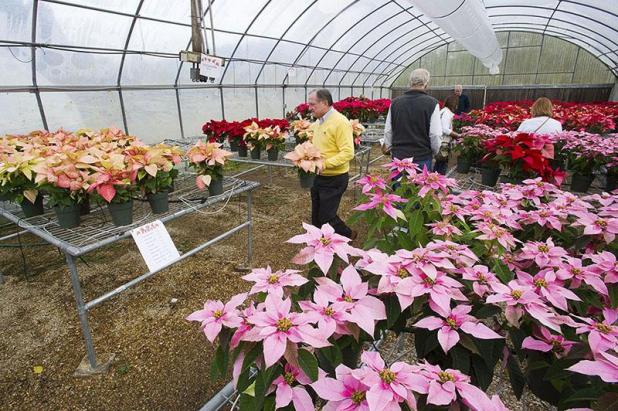
Customers peruse poinsettias on display at the LSU AgCenter Botanic Gardens at Burden annual poinsettia sale. (Photo by Olivia McClure/LSU AgCenter.)
How to properly select and care for poinsettias
The holidays are here and if you haven’t passed by dozens of poinsettias in stores yet then you will soon.
It’s easy to throw caution to the wind and load your shopping cart up when you see all the beautiful shades of red, green and white. Remember, patience is a virtue and taking time to properly inspect plants for damage or imperfections will prevent the disappointment of tossing out a spent plant before the season is over.
Healthy poinsettias can last up to six weeks after purchase. However, if you like a challenge, it is possible to keep a poinsettia around to see next year’s holiday festivities.
When looking for the perfect poinsettia, it is important to familiarize yourself with a little plant anatomy. Unbeknownst to many, the large colored leaves on the top half of the plant are not flower petals but called bracts. The flowers are actually the small yellow and green clusters in the center of the plant, known as cyathia. Because the flowers are so small, the large colorful bracts help in attracting pollinators.
If purchasing a traditional red poinsettia, the lower green leaves should be large, dense and dark in color. Leaves should be attractive with no signs of wilting or curling. Bracts should also be large and robust. Depending on the shade of red (and if not marbled), coloring should be bright and uniform. Leaf drop can occur if bracts are sagging or discolored. Take a step back and look at the shape of the plant. The poinsettia should appear healthy and evenly balanced. Check the cyathia for size and appearance of pollen. If you want a poinsettia that will last a while, choose a plant with small, unopened, and green cyathia. If the cyathia is plump, yellow, and pollen is present, then the plant won’t last as long. While you’re inspecting the plant up close, carefully check underneath bracts and between leaves for insects. It is not uncommon to take home a poinsettia with insects depending on where you purchase them.
Now that you’ve selected your poinsettia, it must be safely transported to your home or office. Poinsettias cannot handle temperatures below 50° F or excessive heat so leaving them in the car while you finish your holiday shopping is not the best idea. Breakage of branches and leaves can be prevented by carefully storing it in a sleeve or placing it in a secure location where it won’t fall over.
When home, remove the sleeve and find a location with at least 6 hours of bright light. Some sources say indirect sunlight is best to prevent fading of color. Avoid over and underwatering. Severe leaf drop can occur if the soil gets too dry, while root rot is very common in overwatered plants. Only use room temperature water and take plants out of decorative wrapping to avoid oversaturation. The best method to determine when it’s time to water is by lightly probing the soil with a finger. If soil is dry and crumbly, it’s definitely time to water. If the soil feels moist and firm, then you’re good to go.
Poinsettias are a true holiday staple. If traditional red, green or white isn’t your thing, then there are plenty of other cultivars to choose from. Bright pinks, speckled reds, marbled yellows and many more brilliantly colored poinsettias are now available to express your unique holiday style.
For more information on poinsettias and other winter ornamentals, contact your parish horticulture agent or visit the LSU AgCenter’s website.
